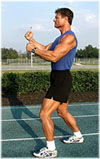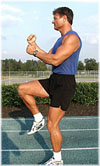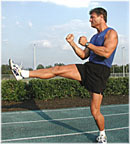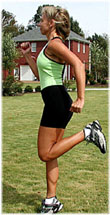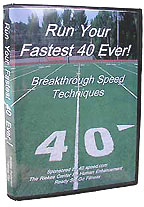
How to develop fast-muscle fiber?
|
||||||||||||||||
|
Everyone interested in dropping body fat, toning muscle, and reversing the effects of the middle-age somatopause, should have a fitness plan that includes developing fast-twitch muscle fiber. Fast muscle fiber
is necessary to perform high-intensity exercise that will release
G H g.rowth hormone during workouts. And plyometric training is the
champion at developing fast-twitch (IIa) muscle fiber, and it also
develops the super-fast (IIx) muscle fiber. All Ages Benefit from Plyometrics Children can increase bone density, strength, and power through plyometric jump drills, (Jumping improves hip and lumbar spine bone mass in prepubescent children: a randomized trial, 2001, Fuchs). Adolescent girls that participate in plyometric training increase bone density, (Effects of plyometric jump training on bone mass in adolescent girls, 2000, Witzke). Premenopausal
women maintain strength and power with plyometric training. Continued
training also reduces important risk factors later in life, (Detraining
reverses positive effects of exercise on the musculoskeletal system
in premenopausal women, 2000, Winters). Plyometrics may aid injury prevention Plyometric drills
may aid in the prevention of ACL (anterior cruciate ligament) injuries.
However, plyometric drills must be performed with adequate warm-up
and a gradual buildup period because some drills - with lateral movements
- can actually cause ACL injury if they're not performed correctly. Plyometric drills can be performed at home Plyometric drills typically involve jumping, skipping, and hopping, but may take many different forms. And they are performed by sets / reps similar to weightlifting. There are many
types of plyometrics. Karate kicks, in many respects, are an example
of standing plyometrics. Jumping drills are plyometrics. And running
with exaggerated high-knees is a plyometric drill called high-knees. Performing the drills The Ready Set Go Fitness plan uses standing and dynamic (moving forward) forms of plyometrics that involve quick, powerful, repeated movements of the stretch-shortening muscular cycle. The first few sets in the plyometric workout call for the traditional karate kicks - front, side and back. Karate Front Kick
start raise knee forward kick
Advanced
Front Kick
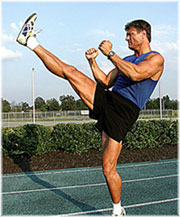
Once plyometric kicks have been accomplished, it's time for the dynamic drills. Initially, perform only one set of the dynamic plyometric drills covering 10-yards in distance.
Progressively build to two sets of 15-yards with a walk-back recovery in-between. These drills should only take 10-minutes initially and build to 20-minutes.
Butt Kickers
Important:
Keep knees pointed downward. There should be lots of leg action
with the heels going (up and down). However, the progress forward
should be equal to the speed of walking.
Scheduling Plyometric Drills
Plyometric drills are a regular part of the Ready, Set, GO! Fitness program beginning at Fitness Level Two. Plyometric workouts should be performed one day a week. Advanced athletes in the Fitness Level Five category have plyometric drills scheduled for two days a week.
Have a great day! Phil
Campbell, M.S., M.A. |
||||||||||||||||
National
Institutes of Health research cited in newsletter,
RECOMMEND THIS NEWSLETTER to friends, relatives and anyone interested in improving fitness click here. RECEIVE THIS FREE
NEWSLETTER
click here. WANT TO CHANGE YOUR
E-MAIL ADDRESS, simply reply to this TO DISCONTINUE receiving this newsletter, click here. NOTE: The purpose of this newsletter is to expand thinking about fitness as an informational source for readers, and is not medical advice. Before attempting the Synergy Fitness program, the Sprint 8 Workout, or any high-intensity exercise program, consult your physician. This is not just a liability warning; it's wise to have a baseline medical exam before beginning a fitness program. Make your physician a partner in your fitness improvement plan.
|
||||||||||||||||
